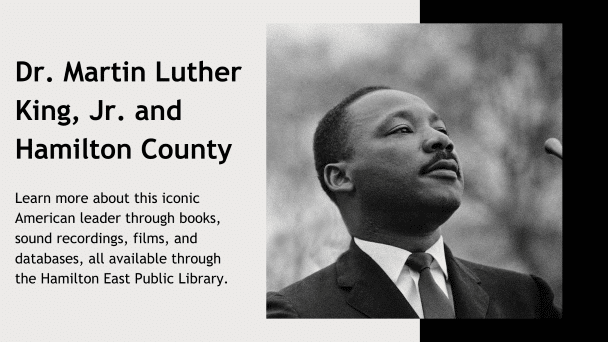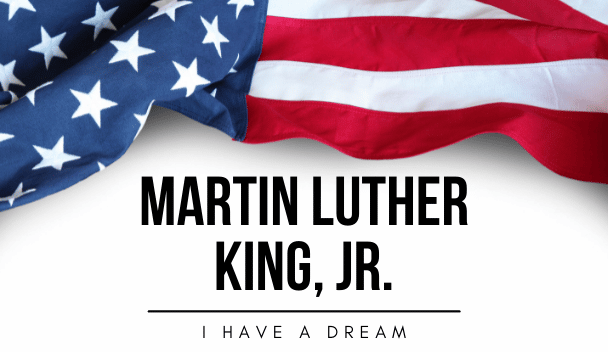By: Hamilton County Historian David Heighway
 As we approach the 93rd anniversary of Martin Luther King’s birth, people are looking at various ways to recognize and celebrate it. Often that involves trying to find some personal connection with the man and his work. While King never visited the Hamilton County area, his actions did have an influence here and are worthwhile to discuss.
As we approach the 93rd anniversary of Martin Luther King’s birth, people are looking at various ways to recognize and celebrate it. Often that involves trying to find some personal connection with the man and his work. While King never visited the Hamilton County area, his actions did have an influence here and are worthwhile to discuss.
Hamilton County’s Rev. Ernest Butler and MLK
Any actual local ties to Dr. King were distant. The minister of the First Baptist Church, Rev. Ernest Butler, was a leader in the civil rights movement in Noblesville in the 1950’s. However, he was transferred to Bloomington in 1959, and sometime after that met and worked with King. Butler continued to be involved in the Civil Rights movement after his move to Bloomington. In a Noblesville Ledger article in 1998, Butler describes King as being a mentor to him and that he was inspired by King’s practice of nonviolent resistance. He also said that King could be fiercely competitive when they would play checkers. A 2014 article in Bloomington Magazine said that Butler participated in the march from Selma to Montgomery in 1965, which has later known as the “Bloody Sunday” march. In the Ledger article, Butler described marching in King’s funeral procession in 1968.
In Hamilton County, like the rest of the country, local African Americans had begun to press for their civil rights in the 1950’s. After World War II, returning African American veterans started speaking up against the status quo. In 1953, Rev. Butler and leaders of the African American community went to the city government and demanded that they end segregation at the Forest Park pool. They asked for fairness and accessibility for what was supposed to be a public facility, pointing out that they were paying taxes for an amenity that they were not allowed to use. There is nothing in the official records, but, according to personal accounts, the city stopped enforcing their restrictions. Blacks were using the pool by 1960 – more than five years after matter surfaced. In 1954, Murphy White was appointed to the Board of Zoning Appeals. In November of 1967, White was elected as the first and only African American city councilor.
The community continued to work on actions to deal with and improve the situation. Martin Luther King was assassinated on April 4, 1968. At nearly the same time, on April 11, the Noblesville city government made an official proposal to create a Human Rights Commission to deal with racial issues in the community. It was organized in May and began work. It had some successes, but was never given much actual authority and it eventually folded. However, organizations like this were still needed. Today, the Noblesville Diversity Coalition and the Fishers-based Racial Equity Community Network (RECN) are making great advances in working to achieve King’s vision.
 MLK Notable Quotes
MLK Notable Quotes
- “The time is always right to do what is right.”
- “Injustice anywhere is a threat to justice everywhere.”
- “Our lives begin to end the day we become silent about things that matter.”
- “I have decided to stick with love. Hate is too great a burden to bear.”
Books & Audiobooks
- The Autobiography of Martin Luther King, Jr., edited by Clayborne Carson, Call Number: B KING, and AUDIO CD B KING
- Martin Luther King, Jr.: A Life, by Marshall Frady, Call Number: B KING 2002
- My Life, My Love, My Legacy, by Coretta Scott King, Call Number: B KING CORETTA SCOTT 2017 and AUDIO CD B KING
- Parting Waters: America in the King Years, 1954 – 63, by Taylor Branch, Call Number: 973.92 BRA
- The Promise and the Dream: The Untold Story of Martin Luther King, Jr. and Robert F. Kennedy, by David Margolick, Call Number: 973.923 MAR 2018
DVDs
- I Am MLK Jr., Call Number: DVD B KING
- King in the Wilderness, Call Number: DVD B KING
- A Ripple of Hope: A True Story of Personal Courage and Responsibility, Call Number: DVD 973.923 RIPPLE
- Selma, Call Number: DVD SELMA
Overdrive: Downloadable eBooks
- Becoming King: Martin Luther King, Jr. and the Making of a National Leader, by Troy Jackson: eBook
- The Civil Rights Movement: Movements That Matter, by Eric Braun: eBook
- Healing Resistance: A Radically Different Response to Harm, by Kazu Haga: eBook
- Martin Luther King, Jr.: Walking in the Light, by John M. Fishman: eBook
- Turning 15 on the Road to Freedom: My Story of the 1965 Selma Voting Rights March, by Lynda Blackmon Lowery: eBook
